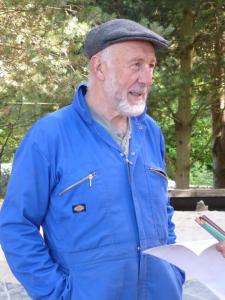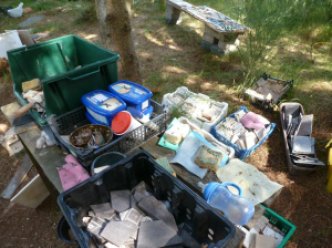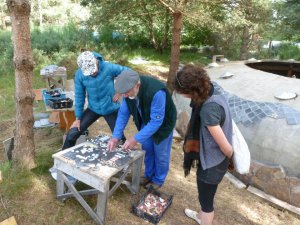I hadn’t expected much from the afternoon. We’d help out with cleaning up Findhorn’s Singing Chamber, a work-in-progress earthen construction. Maybe we’d add some artistic touches if we had the chance. Little did I realize that we would work in the presence of an unexpected sage.
Ian Trumbull is the kind of spritely character that seems to sprout up with regularity in this place. He had on a bright Royal blue work suit so he stood out against the pine needle background. His neatly-trimmed silver beard gave him a bit if gravitas but that was balanced sweetly by a twinkle in his eye that landed him somewhere between a Buddhist monk and a forest elf. Add in a gentlemanly British lilt to his accent and a storyteller’s gift for measured timing, and he had our fullest attention.
Ian explained that we were there for a grand purpose. Findhorn already had its Nature Sanctuary, a half-underground hobbit-like space where the community could meet for meditation, councils, or spiritual matters. This new building was to be a sister, or perhaps a daughter, structure, a place where the community could sing with resonance and harmony. “The whole point,” he noted, “is to balance the two universal forces, the masculine above us and the feminine below us. We live within them and they live within us.” If we felt led to do so, we would help continue the colorful mosaic decoration for the outside of the structure. More specifically, we would help fill in the “night” side, where only the beginning work had been done.
Like the French improvisational bricoleurs who create with whatever materials lie at hand, Ian pointed us to colorful crates and buckets of broken tiles, shards of mirrors, pine cones, buttons, and other random materials. When some in our group hesitated for fear of doing something “wrong,” he coaxed us directly onward: “The most important thing is to start. Get in there and see what emerges.”
His example that followed cracked up our circle. “One time,” he said, “I decided to add a symbolic snake. I was all proud of the idea and so created what I thought was a pretty good snake. When I came back the next morning? I realized it looked more like an elephant.” He simply chipped it out and started over.
For four years, from the time he and his friends wheelbarrowed out the first shovelfuls, Ian has followed this intuitive construction method. He knows enough about roof loads and building codes to make sure the work stays on target as they progress. That baseline expertise allows him to work more in the moment. “We didn’t know what it would become,” he reports. “I find if I already know the end result, I’m just not as interested. If I’m only finishing someone else’s work, where’s the interest in that? This way, we get to see what emerges new every day.”
By welcoming in groups like ours, the project has become more than just Ian’s thing. It’s now a reflection of the whole community, both resident and transient. He does maintain a bit if quality control, but does his best to stay inclusive. I wondered if anyone ever pouted to have their work not pass the test. “Every now and then, someone gets mildly annoyed,” he offered. “I try to let them know that we’re going for a collective image rather than trying to highlight an individual’s contribution. It’s not about ‘making a statement’, it’s about blending into the larger whole.”
The man could be channeling a guidebook on good improvisation. Dive in without knowing the result. Trust that you and your mates can clean up what the unskilled see as “failure.” Forge your own unique path in partnership with the larger group. Trust that the result, a good result will emerge over time. Pay attention and the lessons can come from the least expected corner, even one occupied by a blue-suited Elf Buddha on the coast of Scotland.



